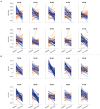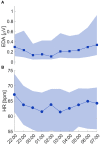Physiological synchrony in electrodermal activity predicts decreased vigilant attention induced by sleep deprivation
- PMID: 38234480
- PMCID: PMC10790929
- DOI: 10.3389/fnrgo.2023.1199347
Physiological synchrony in electrodermal activity predicts decreased vigilant attention induced by sleep deprivation
Abstract
Introduction: When multiple individuals are presented with narrative movie or audio clips, their electrodermal activity (EDA) and heart rate show significant similarities. Higher levels of such inter-subject physiological synchrony are related with higher levels of attention toward the narrative, as for instance expressed by more correctly answered questions about the narrative. We here investigate whether physiological synchrony in EDA and heart rate during watching of movie clips predicts performance on a subsequent vigilant attention task among participants exposed to a night of total sleep deprivation.
Methods: We recorded EDA and heart rate of 54 participants during a night of total sleep deprivation. Every hour from 22:00 to 07:00 participants watched a 10-min movie clip during which we computed inter-subject physiological synchrony. Afterwards, they answered questions about the movie and performed the psychomotor vigilance task (PVT) to capture attentional performance.
Results: We replicated findings that inter-subject correlations in EDA and heart rate predicted the number of correct answers on questions about the movie clips. Furthermore, we found that inter-subject correlations in EDA, but not in heart rate, predicted PVT performance. Individuals' mean EDA and heart rate also predicted their PVT performance. For EDA, inter-subject correlations explained more variance of PVT performance than individuals' mean EDA.
Discussion: Together, these findings confirm the association between physiological synchrony and attention. Physiological synchrony in EDA does not only capture the attentional processing during the time that it is determined, but also proves valuable for capturing more general changes in the attentional state of monitored individuals.
Keywords: electrodermal activity; heart rate; inter-subject correlation; physiological synchrony; sleep deprivation.
Copyright © 2023 Stuldreher, Maasland, Bottenheft, van Erp and Brouwer.
Conflict of interest statement
JE and A-MB declared that they were an editorial board member of Frontiers, at the time of submission. This had no impact on the peer review process and the final decision. The remaining authors declare that the research was conducted in the absence of any commercial or financial relationships that could be construed as a potential conflict of interest.
Figures







Similar articles
-
Robustness of Physiological Synchrony in Wearable Electrodermal Activity and Heart Rate as a Measure of Attentional Engagement to Movie Clips.Sensors (Basel). 2023 Mar 10;23(6):3006. doi: 10.3390/s23063006. Sensors (Basel). 2023. PMID: 36991720 Free PMC article.
-
Electrodermal Activity Is Sensitive to Sleep Deprivation but Does Not Moderate the Effect of Total Sleep Deprivation on Affect.Front Behav Neurosci. 2022 Jul 4;16:885302. doi: 10.3389/fnbeh.2022.885302. eCollection 2022. Front Behav Neurosci. 2022. PMID: 35860724 Free PMC article.
-
Unsupervised Clustering of Individuals Sharing Selective Attentional Focus Using Physiological Synchrony.Front Neuroergon. 2022 Jan 4;2:750248. doi: 10.3389/fnrgo.2021.750248. eCollection 2021. Front Neuroergon. 2022. PMID: 38235215 Free PMC article.
-
Sleep deprivation and vigilant attention.Ann N Y Acad Sci. 2008;1129:305-22. doi: 10.1196/annals.1417.002. Ann N Y Acad Sci. 2008. PMID: 18591490 Review.
-
Sleep deprivation, vigilant attention, and brain function: a review.Neuropsychopharmacology. 2020 Jan;45(1):21-30. doi: 10.1038/s41386-019-0432-6. Epub 2019 Jun 8. Neuropsychopharmacology. 2020. PMID: 31176308 Free PMC article. Review.
Cited by
-
Monitoring audience engagement using electrodermal activity during an inaugural lecture.PLoS One. 2025 Jun 12;20(6):e0326091. doi: 10.1371/journal.pone.0326091. eCollection 2025. PLoS One. 2025. PMID: 40504800 Free PMC article.
-
Intersubject correlation as a predictor of attention: a systematic review.BMC Psychol. 2025 May 22;13(1):546. doi: 10.1186/s40359-025-02879-7. BMC Psychol. 2025. PMID: 40405228 Free PMC article.
-
The Sleep-Wake Cycle Pattern of a Blind Trail Ultramarathon Runner and His Guide: The World's First Case.Clocks Sleep. 2025 Apr 15;7(2):20. doi: 10.3390/clockssleep7020020. Clocks Sleep. 2025. PMID: 40265452 Free PMC article.
-
Seven robust and easy to obtain biomarkers to measure acute stress.Brain Behav Immun Health. 2024 May 9;38:100789. doi: 10.1016/j.bbih.2024.100789. eCollection 2024 Jul. Brain Behav Immun Health. 2024. PMID: 38799794 Free PMC article.
References
LinkOut - more resources
Full Text Sources

